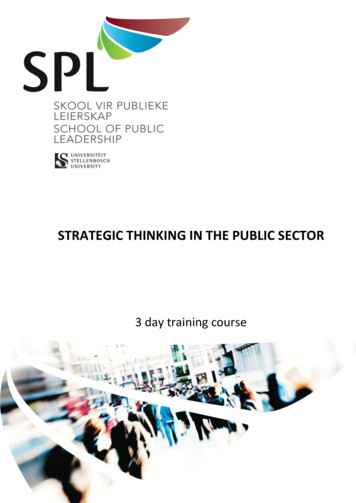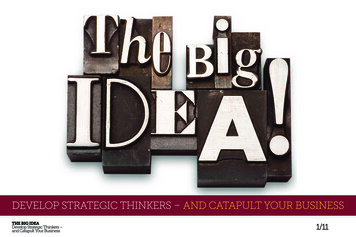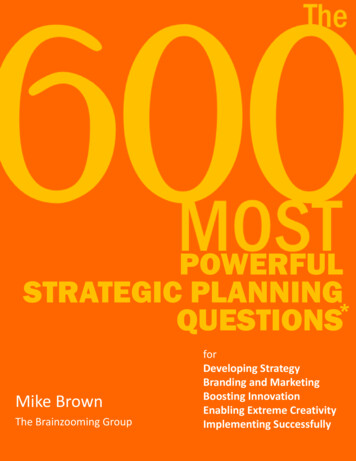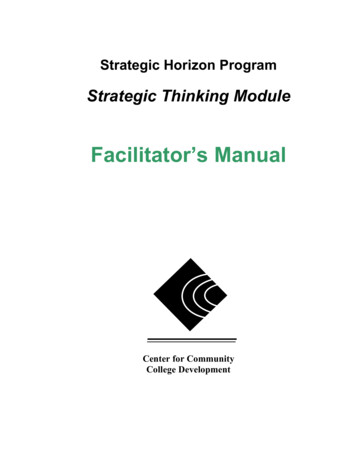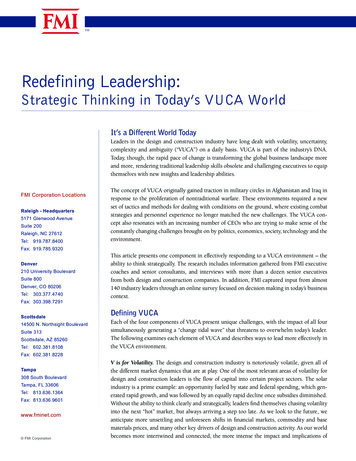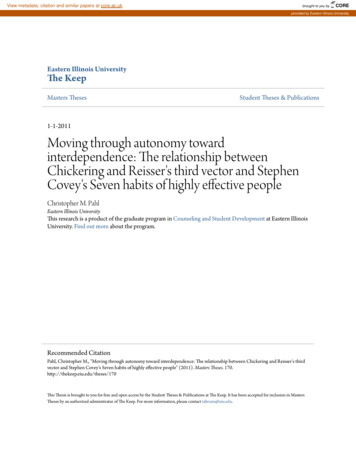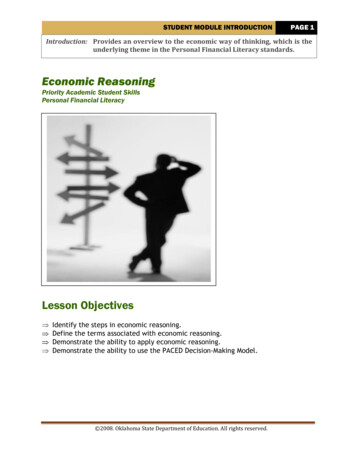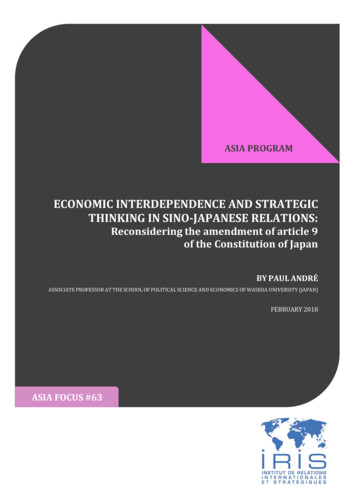
Transcription
ASIA PROGRAMECONOMIC INTERDEPENDENCE AND STRATEGICTHINKING IN SINO-JAPANESE RELATIONS:Reconsidering the amendment of article 9of the Constitution of JapanBY PAUL ANDRÉASSOCIATE PROFESSOR AT THE SCHOOL OF POLITICAL SCIENCE AND ECONOMICS OF WASEDA UNIVERSITY (JAPAN)FEBRUARY 2018ASIA FOCUS #63
ASIA FOCUS #63–ASIA PROGRAM / February 2018This paper aims at understanding the importance of economic interdependence withChina in Japan’s relation to war; and its willingness to amend its pacifist Constitutionand thus to legalize the use of war. I first come back to Raymond Aron’s idea that warcannot be excluded from the industrial society. But the latter changes the relation tothe conflict. Then I use Dale Copeland’s model and I try to demonstrate that theJapanese government is anticipating a Chinese threat which tends to presenteconomic interdependence as a threat and to reinforce Japan’s willingness to ensurenational security by armed forces.War in international relations was often badly thought of. Some might seewar interstate violence as an archaic almost childish modality toapproach international conflicts. For a long time, the study of war in theinternational economy was underdeveloped, and there have been too little books on thistopic. Globalization, the acceleration of economic interdependence, or the proliferationof regional partnerships seem to give more strength to liberalists who consider thedevelopment of international trade is not only a factor in pacifying internationalrelations (commercial liberalism thesis)1 but also it is a factor of democratization. In theliberal theory, democracies do not wage war against each other. Thus, economicinterdependence would distance war from the possibilities in international relations(thesis of market driven democratization and democratic peace 2). In such a context, aparticular relation should be considered carefully that of Japan and the People’sRepublic of China (hereafter China). China has greatly benefited from its open-doorpolicy and its integration into the global economy. However, at the same time, China isthe country which has increased its military spending the fastest over the last recentyears 3. For its part, the Japanese government has shown its singularity in internationalrelations by reaffirming the importance of thinking the role of war in internationalSee for instance Norman Angell, The Great Illusion, A study of relations of military power in nations to their economicand social advantage (London: Heinemann, 1912), or for a contemporary approach, Andrew Moravscik “TakingPreferences Seriously : A Liberal Theory of International Politics”, International Organization, 51(4), Autumn 1997,pp513-553.2 The origins of this trend can be Barrington Moore, Social Origins of Dictatorship (London: Penguin Books, 1966).3 According to SIPRI annual reports. For year 2016, only India (among great powers) experienced a higher rise ofmilitary spending ( 8.7% between 2015 and 2016, 6% for China).12
ASIA FOCUS #63–ASIA PROGRAM / February 2018relations and the imperative need to amend the article 9 of the 1947 pacifistConstitution. Having reintroduced violence as a potentiality of politics, Abeadministration was sometimes accused of belligerency and had to clear itself of anymilitarism.When the Japanese government proposes to amend the Constitution (article 9), itreintroduces war and interstate violence into the political debate. So war and violencecease to be mere concepts and become a potentiality from which it is worth beingprotected. If the Constitutional reform has vast consequences (indeed it is difficult toimagine Japan going back to pacifism if the situation changes in the short run), it cannotbe understood without taking into account the particular context which led Japaneseleaders to reconsider war. This is, of course, the relation with China that is beingdiscussed here. Understanding the Japanese constitutional amendment requires to lookat China’s vision of the world and how China considers conflict. Since China and Japanare closely economically interdependent, all levels of opposition have to be considered.However, it has to be noted that, over the last few years, there has been a shift fromeconomic warfare or trade war to war as a form of violence. How can the evolution beexplained? How can war be thought when the security threat is at the same time themain economic partner?This paper will be based on two intellectual orientations: Raymond Aron’s thought andinternational political economy (IPE). Aron was one of the few scholars who consideredwar into the industrial society. In the third part of Espoir et peur du siècle (Hope and Fearof the Century), he wrote that war is a chameleon. This remark invites us to also considereconomy in a security and strategic perspective, and vice versa. Additionally, it seemsthat the realist school in IPE can provide an innovative perspective on Sino-Japaneserelations. Therefore, this theory may be helpful to understand how Japan’s thought onwar was led to evolve. These two approaches will be used to study the strategic doctrineof the two actors but also decisions. Therefore bilateral relations between China andJapan will be studied during the contemporary period (2012-2016) 4 without, however,neglecting older aspects that this problem raises. Beyond the mere study of bilateral4In 2012, indeed Xi Jinping took office and Abe Shinzo returned to power.3
ASIA FOCUS #63–ASIA PROGRAM / February 2018relations, the question here is how to rethink war in a context of complexinterdependence of a constitutionally pacifist country with a neighbour seen as anobjective security threat.In this purpose, I first start from the thought of Raymond Aron in order to reconsiderwar as a political phenomenon in industrial societies (§1.). This will lead us in a secondtime to see how theories of international relations and of international economics tacklejointly war and economic interdependence (§2.). These intellectual clarifications willallow to study the case of Sino-Japanese relations which was long considered as acomplex interdependence and whose security dimension has become more important inthe last decade (§3.). This evolution seems to be the result of the perception that bothactors have of their own safety (§4.). I will conclude with an attempt of analysis of thesignificance given to war by Japan today and the new understanding of the article 9 ofthe Japanese Constitution (§5.).WAR IN THE INDUSTRIAL SOCIETY: “WAR AS A CHAMELEON” (ARON)Some pioneering works as Hirschman in 1945 5 already highlighted the link betweeneconomy and war at the industrial age. The debate about the relationship betweeneconomic interdependence and war produced a vast literature 6 in both the fields ofeconomics and international relations. On the one hand, as Montesquieu famously put it“the natural effect of commerce is to lead to peace. Two nations that trade togetherbecome mutually dependent: if one has an interest in buying, the other has an interest inLet’s note that Aron was not the only one who studied this phenomenon. Among pioneers of this approach, let’smention the now classic thesis of Albert Hirschman on national power and the structure of foreign trade. In thissurvey, Hirshman explains how governments use trading relations to increase their power. Starting from theassumption that trading partners will not necessarily get the same benefits, it is therefore an assimetric relation. Theless dependent country can try to instrumentalize the situation in order to reinforce its power. Hirschman thusconsiders that Germany used its trade policy to expand its sphere of influence in Eastern Europe during the 1930s.Albert Hirschman, National Power and the Structure of Foreign Trade (Berkeley: University of California Press, 1945expanded edition 1980). Another example is the pioneering work of Jacob Viner, who in 1948 explores therelationship between power and wealth as goals of foreign policy. Jacob Viner, "Power Versus Plenty as Objectives ofForeign Policy in the Seventeenth and Eighteenth Centuries", World Politics. Vol. 1, No. 1 (Oct., 1948), pp. 1-29. Finally,Richard Cooper, can be mentioned as one of the first to be interested in the effects of economic interdependence onstate sovereignty. Richard Cooper, The Economics of Interdependence, (New York: Columbia University Press, 1968).6 For a general presentation of the debate, see for instance Derek Braddon, “The Role of Economic Interdependence inthe Origins and Resolution of Conflict” Revue d’Economie Politique 2012/2 (Vol. 122), p299-319.54
ASIA FOCUS #63–ASIA PROGRAM / February 2018selling; and all unions are based on mutual needs” 7. This liberal tradition emphasizesthat economic interdependence would increase the “opportunity-cots” of a war and,thus, limits the likeliness of war 8. The classical commercial peace theory has beenmodified. For instance, Rosecrance 9 reminds that economic relations are a moreefficient way to improve a state’s welfare than the use of force.On the other hand, Mansfield and Pollins 10 remind that critics of this liberal perspectiveunderline that economic interdependence may undermine national security 11. AsBraddon reminds it, “we know that conflict are linked through a variety of channels oftransmission but we are unclear about the direction of causality, and indeed whatfactors are exogenous and what endogenous” 12. In other words, the issues of causalityand endogeneity are crucial. That means that in some cases, economic interdependencemay limit the chances of conflict, while in some other cases it may increase them.According Martin, Mayer and Thoenig 13, bilateral trade relations tend to act as apacifying factor while the probability of escalation seems more important in case ofmultilateral trade relations. Empirical evidences reveal that the conventionalcommercial peace theory is somewhat less plausible and dated. For instance, Gartzkeand al. 14 empirical survey points out that it is the very notion of economicinterdependence that has to be clarified. Their conclusion suggests that capitalinterdependence “contributes to peace independent of the effects of trade, democracy,interest and other variables”. In the same idea, Barbieri 15 puts that trade does notMontesquieu, The Spirit of the Laws (Cambridge: Cambridge University Press, 1989) Book XX, Chapter 2See for instance Erik Gartzke, Quan Li and Charles Boehmer, “Investing in the Peace: Economic interdependence andinternational conflict” International Organization, 2001, vol. 55(2)9 Richard Rosecrance, The Rise of the Trading State: Commerce and Conquest in the Modern World (New York: BasicBooks, 1986).10 Edward Mansfield and Brian Pollins (ed.), Economic Interdependence and International Conflict: New Perspectiveson an Enduring Debate (Ann Arbour: University of Michigan Press: 2003)11 See for instance Robert Gilpin, Global Political Economy: Understanding the International Economic Order(Princeton NJ: Princeton University Press: 2001); John Mearscheimer “Why we will soon miss the Cold War” TheAtlantic Monthly, 1990 Volume 266, No. 2; pages 35-50; Katherine Barbieri, “Economic Interdependence: A Path toPeace or a Source of Interstate Conflict?” Journal of Peace Research, 1996, vol. 33, no1, pp.29-49; Katherine Barbieri,The Liberal Illusion: Does Trade Promote Peace? (Ann Arbour: The University of Michigan Press, 2005); KatherineBarbieri and Gerald Schneider, “Globalization and Peace: Assessing New Directions in the Study of Trade and Conflict”Journal of Peace Research, 1999, vol.36, no.4, pp.387-404.12 Braddon, “The Role of Economic Interdependence in the Origins and Resolution of Conflict”, p302.13 Philippe Martin, Thierry Mayer and Mathias Thoenig, “Make Trade not War” The Review of Economic Studies, 2008,vol. 75, Issue 3, pp.865-900; Philippe Martin, Thierry Mayer and Mathias Thoenig, La Mondialisation est-elle un facteurde paix ? (Paris: Editions de la rue d’Ulm: 2006).14 Gartzke and al., “Investing in the Peace: Economic interdependence and international conflict”15 Barbieri, “Economic Interdependence: A Path to Peace or a Source of Interstate Conflict?”785
ASIA FOCUS #63–ASIA PROGRAM / February 2018compulsorily promote peace. “The precise nature and appropriate context of a particularset of economic interdependencies must be taken into account when assessing whethersuch linkages encourage or ward off potential military conflicts” 16.Retrospectively, Aron’s theoretical contribution to the question is surprisinglyinnovative because he gathered in his analysis the study of the relation between thepolitical framework and the economy into the industrial society; the logic of rivalrybetween powers; and the study of communism. Aron was the first to question the verymeaning conflictuality could take in the industrial society. In 1963, he reminded it inanother text:“It is rare, for many years, that professors devote their time andreflection to strictly military problems. For being traditional, thislack is nonetheless unfortunate.In the teaching of political science and history, the study ofmilitary institutions, the study of the relations between theseinstitutions and states or social systems should have had a largerpart than which has actually been granted. It was deplorable toset the story of battles at the forefront, it would be unreasonableto forget that wars have been an endemic phenomenonthroughout the centuries and that weapons as tools are at thesame time the expression of a society and one of the factors whichcommand its organization. Moreover in democracy, nationaldefence directly involves the citizen. Why wouldn’t he try toacquire enough knowledge to understand the problems?” 17Importance of war but also its forgetfulness. Because war would be seen as irrationaland too costly, this led to the too hasty presupposition that the development ofinternational economic relations and economic development will make war impossiblein industrial nations. I would like to focus on two texts of Aron on this very aspect: the1617Braddon, “The Role of Economic Interdependence in the Origins and Resolution of Conflict”, p306.Raymond Aron, Le Grand Débat [The Great Debate] (Paris: Calmann-Levy, 1963), p7. Translation by the author.6
ASIA FOCUS #63–ASIA PROGRAM / February 2018third part of Espoir et peur du siècle (Hope and Fear of the Century)18 and La guerre dansla société industrielle (War in the industrial society) 19. In the later, Aron starts fromAuguste Comte’s hypothesis that war is led to disappear within the vanguard of theindustrial society. 1870 Franco-Prussian war then WW1 and WW2 brought a sharpdenial to the father of positivism’s prediction. Yet rather than condemning Comte as awhole Aron uses this mistaken prediction to question the place of violence and interstate conflict within industrial societies.Reading these two texts, the first striking element is the very modern, still current andsometimes visionary aspect of Aron’s analysis. He actually explains in industrial societyand war that mankind is for the first time in its history in presence of a planetarydiplomacy. There would have a global but divided society. This observation was made byAron in the 1950s when he wrote this text; we can certainly go further today andconsider that we are nowadays in a global society. With this global diplomacy, aspectacular development of international economic relations has been witnessed.Reading Aron, it cannot be forgotten that two ruptures occurred after 1945. First, withthe development of nuclear weapons, total war ceased to be a rational objective ofpolitics. Second, war of conquest i.e. war with economic objectives also became anabsurdity. Aron believes humanity should be much more pessimistic about the future ofpeace if weapons of mass destruction did not exist. “Nuclear weapons are the bestchance that there will be no great wars [again]; for the first time in history Clausewitz’sfamous quote war is the continuation of politics by other means becomes wrong. It isno longer true today that thermonuclear war is a rational instrument in the pursuit of apolitical objective: it would be madness.” 20 As an analyst of industrial societies, however,Aron did not limit to consider war only as a security phenomenon. For him still in thesame text “war of conquest in industrial societies has become an absurdity. Conquest isa derisory, anachronistic and almost childish process of enriching people. There isabsolutely no need to conquer to enrich peoples. A well-organized labour is enough. Thisdoes not mean that men will not prefer to enslave one another even if they deriveRaymond Aron, Espoir et peur du siècle, essais non partisans [Hope and Fear of the Century. Non-partisan Essays](Paris : Calmann-Lévy, 1957). p246-346.19 Raymond Aron, La société industrielle et la guerre [Industrial Society and War] (Paris : Plon, 1959).20 Interview of Raymond Aron on French television about Industrial Society and War, Lectures pour tous, Octobre 21st1959, available at http://www.ina.fr/video/I00017855187
ASIA FOCUS #63–ASIA PROGRAM / February 2018nothing from it. But again, as with the ability to destroy, the fact that war becameirrational prohibits to lose hope or courage. Because the rationality of the industrialsociety is not to exclude any violence but it is to exclude the excessive, hyperbolicviolence of great wars of the past.” In other words, some theoretical assumptions aboutany correlation or supposed correlation between economic development and/oreconomic interdependence and war have to be re-examined. In this case, this calls twoliminal remarks. First following has been said, it can be considered the South China Seaconflict is deeper and more serious than merely seeking the monopoly of resources.Second keynote remark, Prime Minister Abe’s willingness to amend article 9 of theConstitution should not be only understood as a militaristic inclination. Perhaps itshould be also understood as a will to take into consideration war as a phenomenonwhich has never disappeared in industrial societies.Let’s now come back to the idea that the development of the market in China would haveled to a détente between the PRC and its neighbours and first and foremost Japan.When China implemented economic reforms to transform its planned Soviet economyinto a form of market, it could have been legitimately seen as a form of appeasement ofthe ideological conflict. This ideological conflict could have been understood as a relic ofthe cold war. Precisely in 1959 in Industrial society and war, Aron tried to identify theconditions for a real peace i.e. a situation which is not merely the absence of war. Inother words, he reminds us that “non-war” is not peace. Aron believed that theconditions of the establishment of true peace laid in reducing the standard of livingbetween developed countries and the Third World. Moreover, he backed the creation ofgenuine political societies because violence is often linked to the formation of nationalgroups. Finally (and perhaps above all), it was necessary to appease the ideologicalconflict between the two main industrial societies (Aron had in mind here the UnitedStates and the USSR). The US and the USSR should emphasize on their common pointsinstead of emphasizing on their opposition.Aron’s clairvoyance in the understanding of communist regimes economic logic isstriking. Indeed, as early as 1959, Aron explains that the cessation of the ideologicalconflict between the USA and the USSR can happen quite easily. He, however, points out8
ASIA FOCUS #63–ASIA PROGRAM / February 2018two crude misunderstandings. The first one consists in the belief that America and theUSSR because they would have progressively the same kind of economic organization(i.e. a marketization of the economy in China today for instance) should reach the sameform of society. Aron considers this hypothesis as an “ultra-vulgar ultra-Marxism” 21. Themeaning of the ideological conflict between communist regimes and capitalist regimeshas been overestimated. Indeed, Marxism claimed that industry plus private propertyleads to the misery of the majority. This is clearly false. In the West, the proposition hasoften been inverted, claiming that industry plus sovietism entail misery of the masses. Itis just as exaggerated. Both propositions are false. Industry, whatever the regime, bringsa certain degree of “gentrification”. Aron specified “the result will not be that these twoenemy brothers will stop fighting, but the ideological conflict seems to me to be so basedon misconceptions that I cannot believe that this ideological conflict can be decisive for along time”. Thus the determinants of the conflict may be different. The search for powerwould then become an explanatory element of the rise of Chinese military power.Considering that communism as it was lived in the USSR was not the equivalent of areligion but at the most the equivalent of faith in private property andentrepreneurship in the US, Aron said “with a little imagination, we can imagine theRussians raising their hat to the statue of Karl Marx whenever they reintroduce a dose ofmarket mechanisms in their economy. Nothing is easier in economic ideology than toforget them in practice. We are not there yet, but it is perfectly conceivable” 22. Hedescribes exactly the process of economic reforms in China. Thus, one understands thatthe development of the market would not necessarily lead to the abandonment ofcommunism and the geopolitical-ideological rivalry it carries within it.If it is considered that violence cannot be excluded of the realms of possibility in theindustrial society, then the forms and modalities of this violence between industrialsocieties should be questioned. As mentioned, Aron explains that the rationality ofindustrial societies is not to exclude any violence but it is to exclude hyperbolic,excessive violence. In other words, total wars of the past seem to be out of the scope.21 After all, within the archaic societies there was a great community of organization and a great diversity oforganization and culture. There is no reason why the different diversities of political organization or of culturesshould disappear because of a convergence of labour organizations forms.22 Aron, Interview.9
ASIA FOCUS #63–ASIA PROGRAM / February 2018But, since violence cannot be out of the scope, total wars of the past will be replaced byanother form of war. What Aron tells us is that war is a chameleon 23. If war does notassume the appearance of a total conflict, then it can take the a priori lessened form ofa guerrilla or economic warfare.Why should economic warfare or even economy be considered in strategic thinking?Because this is a problem that comes under the heading of military competition. When,in 1957, Aron commented on the solution adopted for the choice of rearmament inWestern Europe, he considered that “[ ] it was obviously not the right decision: if aEuropean country is not capable to maintain more than a dozen of American styledivisions, then this country must adopt another standard.” Aron therefore proposes tofind what can be this “other standard”. Guerrilla warfare cannot possibly be consideredas a credible option in the conflict between two economic powers (respectively thesecond and the Third World economic powers). It is all the more unrealistic that theireconomic interest seem so closely linked (see below). Aron reminds that regular armiesdo not have the monopoly of combat 24. But he also points out the limits of guerrillawarfare 25. This should raise the question of economy in warfare. Let’s be clear, there isno point here putting economic pressure and armed conflict at the same level. But thepurpose here is rather to reintroduce the use of the economy in the series of lever agovernment may have in order to achieve a goal which is political by definition. If asAron always reminded it war must be seen as a violence with political aim; then war isonly a gradation (the ultimate gradation) in the list of answers a government has toachieve this political objective. If “guerrilla warfare alone never triumphed in thiscentury of any regular army”, we can also consider that economic pressures are not awar. But they can be a dimension of this political phenomenon that war is. In otherwords, if war is the continuation of politics by other means, can’t it be also consideredthat economy under certain conditions is also the continuation of politics by othermeans.Aron, Espoir et peur du siècle, 3rd part.Aron, Espoir et peur du siècle, p 295.25 Aron, Espoir et peur du siècle, p 296.232410
ASIA FOCUS #63–ASIA PROGRAM / February 2018This last question obviously invites us to high caution and it also requires a number ofclarifications. It would be a mistake to artificially apply a security perspective tophenomena that does not necessarily belong to it. However, it would be the sameblindness to exclude by definition the security dimension of economic relations. Nothinga priori allows to conclude that economic relation aims at the submission to the other’swill. But nothing also allows to exclude the blinding power of economicinterdependence.ECONOMIC WARFARE AND ECONOMIC INTERDEPENDENCEMy goal is not here to dwell on the question of economic warfare. My purpose is ratherto emphasize on the importance or the impact of economic interdependence may havein the way war is thought. Of course, economic interdependence can be seen from awarlike perspective. Some Chinese authors are among the references on the subject suchas Qiao Liang and Wang Xiangsui 26. But the thought was made in a framework where thestatist actor remained as the corner stone. Here it seems the issue is more subtle.Indeed, the way the Japanese government has to rethink war implies interstatistrelations but also relations with transnational private actors. Thus, this is aninterdependence framework which results from a plurality of logics (the logic ofnational interest or Raison d’Etat and private logics).Such a situation is rather well described by what international political economy callscomplex interdependence. This concept was created in 1977 by Keohane and Nye intheir book Power and Interdependence 27. Their starting point was to say that“contemporary world politics is not a seamless web, it is a tapestry of diverserelationships. In such a world, one model cannot explain all situations.” 28 States wouldthus evolve in a complex interdependence which has three main characteristics.International relations are achieved through multiple channels of communication (firstcharacteristic) because there is an absence of hierarchy in the agenda of interstateQiao Liang and Wang Xiangsui, Unrestricted Warfare (Beijing: PLA Literature and ArtsPublishing House, 1999).27 Robert Keohane and Joseph Kye, Power and Interdependence (Boston: Longman, 1977).28 Keohane and Nye, Power and Interdependence, p4.2611
ASIA FOCUS #63–ASIA PROGRAM / February 2018relationships (second characteristic). Thus, military force is less central (thirdcharacteristic). With this concept Nye and Keohane challenged then dominant neorealisthypothesis. Actually, economic interdependence would create a variety of transnationalactors who through their access to channels of communication could have asignificant influence on international relations. Economic interdependence thusmultiplies relations at stake between two or more countries: trade, finance, technology,raw materials, jobs, energy, and environment. Security is not only the only issue at stake.But the hierarchy of issues is fluctuating according to the context. Power becomes thendiffuse. In such a situation, the use of force is not efficient 29. As mentioned above, Aronalready raised this point. But it would be an overstatement to say that Aron was aproponent of this theory. In a way, Keohane and Nye question war because theyquestion the very concept of power. In this context indeed, power becomes the abilityfor a government to control over outcomes. However interesting it may be, this conceptof complex interdependence tends to set as a constant an absence of hierarchy amongissues at stake. Actually, if this scenario could have happened, it seems to be a muchcontextualized situation. Specifically referring to East Asia, Joseph Nye promised,however, that “security is like oxygen: you tend not to notice it until you begin to loseit.” 30 The concept of complex interdependence has the advantage of establishing twodimensions that make it possible to understand the role of power in a relation ofinterdependence: sensitivity and vulnerability. Keohane and Nye define sensitivity as“degrees of responsiveness within a policy framework.” 31 Sensitivity relies therefore onthe assumption that a country’s political framework remains unchanged. In other words,the concept of sensitivity points out how changes within a country will bring costlychanges in another country. While “the vulnerability dimension of interdependencerests on the relative availability and costliness of the alternatives that various actorsface” 32. This distinction is useful to understand the relation between power andinterdependence. “Clearly, it indicates that sensitivity interdependence will be lessimportant than vulnerability interdependence in providing power resources to actors. If29 For further development, see for instance the analysis made by Stéphane Paquin. Stéphane Paquin, La nouvelleéconomie politique international, [The New International Political Economy] (Paris: Armand Colin, 2008) p48.30 Joseph Nye, “East Asian Security: The case for deep engagement” Foreign Affairs; July/August 1995.31 Keohane and Nye, Power and Interdependence, p10.32 Keohane and Nye, Power and Interdependence, p1112
ASIA FOCUS #63–ASIA PROGRAM / February 2018one actor can reduce its costs by altering its
economy in a security and strategic perspective, and vice versa. Additionally, it seems that the realist school in IPE can provide aninnovative perspective on Sino -Japanese relations. Therefore, this theory may be helpful to understand how Japan's thought on war was led to evolve. These two approaches will be used to study the strategic doctrine
